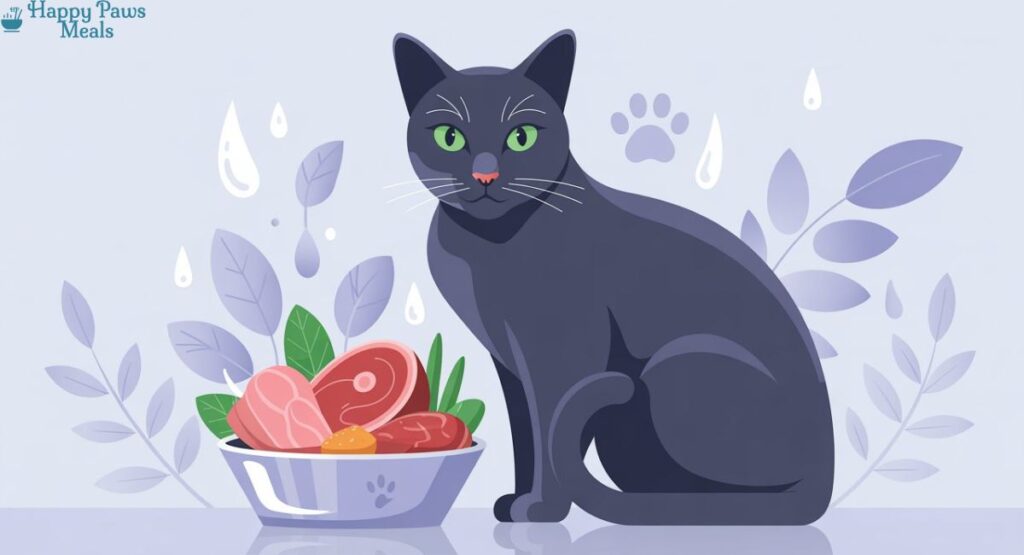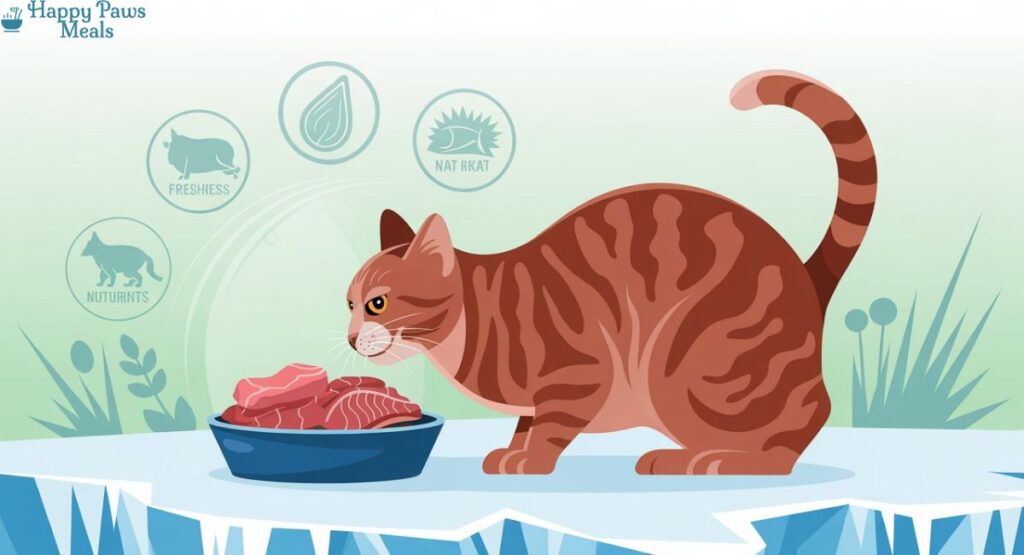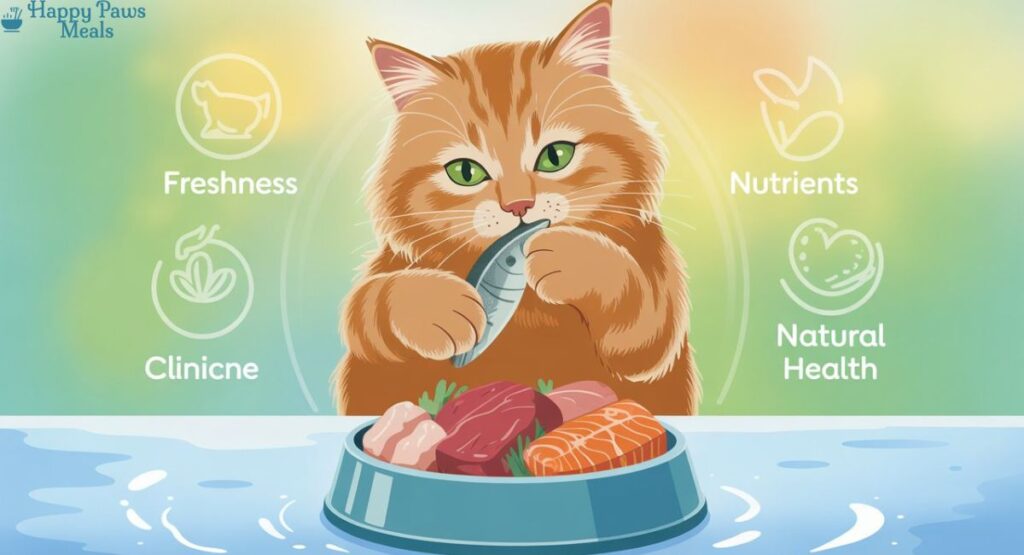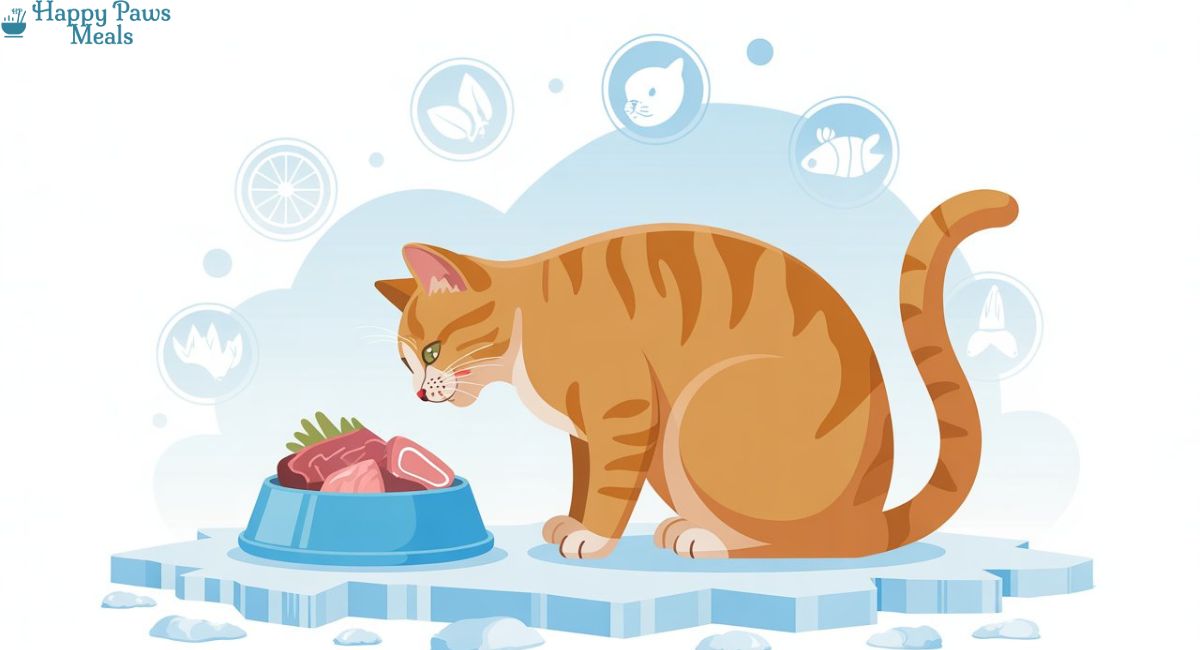Frozen raw cat food is becoming one of the fastest-growing trends in feline nutrition. Many cat parents are making the switch from traditional kibble to frozen raw diets, believing that it provides a more natural and biologically appropriate way to feed their pets. But what exactly is frozen raw cat food, and is it safe for your cat?
In this guide, we’ll explore everything you need to know: what frozen raw cat food is, its benefits and risks, nutritional value, safety guidelines, best brands, and frequently asked questions. By the end, you’ll know whether this diet is the right choice for your furry friend.
👉 Commercial raw diets are usually balanced to meet AAFCO nutrient standards, ensuring that cats get all essential vitamins, minerals, and amino acids.
What is Frozen Raw Cat Food?
Frozen raw cat food is exactly what it sounds like—uncooked, minimally processed food made primarily from animal-based ingredients. It typically includes:
- Muscle meat (chicken, beef, turkey, rabbit, lamb, or fish)
- Organs (liver, heart, kidney—rich in vitamins and minerals)
- Ground bones (source of calcium and phosphorus)
- Supplements (like taurine, omega-3s, and probiotics to ensure balance)

The food is prepared fresh and then frozen to preserve its nutritional integrity and prevent spoilage. Unlike kibble or canned food, it is not cooked, meaning cats get the full nutritional profile of raw ingredients.
Why Frozen?
Freezing keeps the food safe by slowing bacterial growth, extending shelf life, and preserving nutrients. It also makes handling easier for pet owners compared to fresh raw diets.
Nutritional Profile of Frozen Raw Cat Food
Cats are obligate carnivores, meaning they thrive on high-protein, meat-based diets. Frozen raw food closely mimics what wild cats would eat in nature. Here’s the typical nutritional breakdown:
- Protein: 50–65% (supports muscle maintenance, growth, and energy)
- Fat: 25–30% (provides essential fatty acids for skin, coat, and energy)
- Moisture: 60–70% (important for hydration, since cats often don’t drink enough water)
- Vitamins & Minerals: Naturally occurring in meat, bones, and organs (plus added supplements for balance)
- Taurine: Essential amino acid for heart health, vision, and reproduction
Compared to kibble, frozen raw food contains more protein, fewer carbs, and significantly higher moisture—closer to a cat’s natural diet.
👉 According to the FDA’s raw pet food safety guidelines, proper storage and handling are essential to prevent contamination and protect both pets and owners.
Benefits of Frozen Raw Cat Food
Switching to frozen raw cat food can provide several health benefits:
✅ Better Digestion
Many cats experience improved stool quality and less digestive upset. Raw diets are easier to digest because they are free from fillers like corn, soy, or wheat.
✅ Improved Hydration
Since frozen raw food contains 60–70% moisture, it helps prevent urinary tract infections and kidney problems that are common in cats fed dry kibble.
✅ Shinier Coat & Healthier Skin
High-quality proteins and fatty acids (omega-3s and omega-6s) support a soft, shiny coat and reduce shedding.
✅ Stronger Teeth & Bones
Ground bones or meaty chunks help maintain dental health by reducing plaque buildup. Calcium from bones also strengthens skeletal health.
✅ Weight Management
Frozen raw diets are typically low in carbs and high in protein, which helps maintain lean muscle mass and prevents obesity.
✅ Natural Eating Behavior
Cats enjoy the texture and taste of raw meat, making mealtime more instinctually satisfying.

Risks & Safety Concerns
While frozen raw cat food has benefits, it’s not without risks:
❌ Bacterial Contamination
Raw meat can contain Salmonella, E. coli, or Listeria. While cats tolerate these bacteria better than humans, contamination is still a concern for pets and owners.
❌ Nutritional Imbalance
DIY raw diets may lack essential nutrients like taurine or calcium. Commercially prepared frozen raw foods are usually balanced to meet AAFCO standards.
❌ Storage & Handling
Raw food must be properly stored and thawed to remain safe. Mishandling can increase contamination risks.
Is Frozen Raw Cat Food Safe?
Yes—when purchased from reputable brands and handled correctly.
- FDA & AAFCO Approved: Many commercial raw diets meet regulatory safety standards.
- Vets’ Perspective: Some veterinarians recommend it, while others prefer cooked diets due to safety concerns.
- Owner Responsibility: The key is safe handling—washing hands, disinfecting surfaces, and not leaving food out for long periods.
👉 If you’re still comparing different options, you might also want to check our guide on Chewy Cat Food: Best Picks for Healthy & Happy Cats in 2026.
Frozen Raw Cat Food vs Freeze-Dried Raw vs Kibble
Here’s a quick comparison:
| Feature | Frozen Raw Cat Food | Freeze-Dried Raw | Kibble |
|---|---|---|---|
| Processing | Raw, frozen | Raw, freeze-dried | Highly processed |
| Moisture | 60–70% | <5% (rehydrated later) | 8–10% |
| Nutrients | High retention | Good retention | Lower retention |
| Shelf Life | Months (frozen) | Years (dry) | Years (dry) |
| Convenience | Needs freezer | Lightweight & easy | Super convenient |
| Cost | Higher | Moderate to high | Lower |
Popular Brands of Frozen Raw Cat Food
Here are some of the most trusted brands:
1. Stella & Chewy’s
- Wide range of frozen raw patties and morsels.
- Grain-free, high-protein recipes.
- Popular for quality and convenience.
2. Primal Pet Foods
- Uses organic produce and antibiotic-free meats.
- Frozen nuggets for easy portioning.
- Strong focus on sustainability.
3. Instinct Raw (Nature’s Variety)
- One of the largest commercial raw brands.
- Offers both frozen raw and freeze-dried options.
- Known for balanced, AAFCO-approved formulas.
4. Smallbatch Pets
- Family-owned brand using local, organic ingredients.
- Variety of proteins including rabbit and duck.
- Trusted by holistic pet owners.
5. Raw Paws Pet Food
- Specializes in raw frozen meats and complete diets.
- Great for cat parents wanting customizable raw feeding.
Buying Guide: How to Choose Frozen Raw Cat Food
When shopping, consider:
- Ingredients: Look for whole meats, organs, and bones.
- AAFCO Compliance: Ensures balanced nutrition.
- Protein Variety: Rotate proteins to avoid sensitivities.
- Brand Reputation: Stick to well-reviewed, transparent companies.
- Your Cat’s Needs: Age, health condition, and preferences matter.

How to Transition Your Cat to Frozen Raw Food
Cats are creatures of habit, so switching diets takes patience:
- Start Slow: Mix small portions of raw food into your cat’s current diet.
- Increase Gradually: Over 7–14 days, increase raw and decrease kibble/wet.
- Monitor Digestion: Watch stool quality and appetite.
- Be Flexible: Some cats prefer raw mixed with wet food rather than alone.
Storage & Handling of Frozen Raw Cat Food
- Storage: Keep sealed in the freezer until ready to use.
- Thawing: Thaw in the refrigerator, not at room temperature.
- Feeding: Serve within 30 minutes to avoid spoilage.
- Hygiene: Wash bowls, surfaces, and hands after handling.
FAQs About Frozen Raw Cat Food
1. Is frozen raw cat food safe?
Yes, if purchased from a trusted brand and handled correctly.
2. Can kittens eat frozen raw diets?
Yes, but they require balanced formulas designed for growth.
3. Do vets recommend frozen raw cat food?
Opinions vary. Some vets support it, others prefer cooked diets.
4. How long does frozen raw cat food last?
Typically 6–12 months in the freezer.
5. Is frozen raw cat food expensive?
Yes, it usually costs more than kibble, but many owners see it as an investment in long-term health.
6. Can I make my own raw cat food at home?
Yes, but it must be nutritionally balanced with supplements. Most owners prefer commercial formulas for safety.
7. Is frozen raw better than freeze-dried?
Both are good. Frozen raw has more natural moisture, while freeze-dried is more convenient.
Related Articles (Internal Links)
- [Chewy Cat Food: Best Picks for Healthy & Happy Cats in 2026]
- [Top Online Cat Food Calculators]
- [Best Dry Cat Food for Cats in 2026]
Final Thoughts
Frozen raw cat food offers a biologically appropriate, nutrient-rich, and highly digestible diet for cats. While it requires proper handling and costs more than kibble, many owners report better digestion, shinier coats, and overall improved health.
If you decide to switch, choose a trusted brand, transition gradually, and always follow safe food-handling practices. Done right, frozen raw feeding can give your cat the closest thing to a natural, wild diet—right at home.

I’m Awais Manzoor, the writer behind HappyPawsMeals. With years of interest in pet care and nutrition, I research and review cat and dog food to provide reliable, easy-to-understand advice for pet parents.


1 thought on “Frozen Raw Cat Food: A Complete Guide for Cat Parents in 2026”